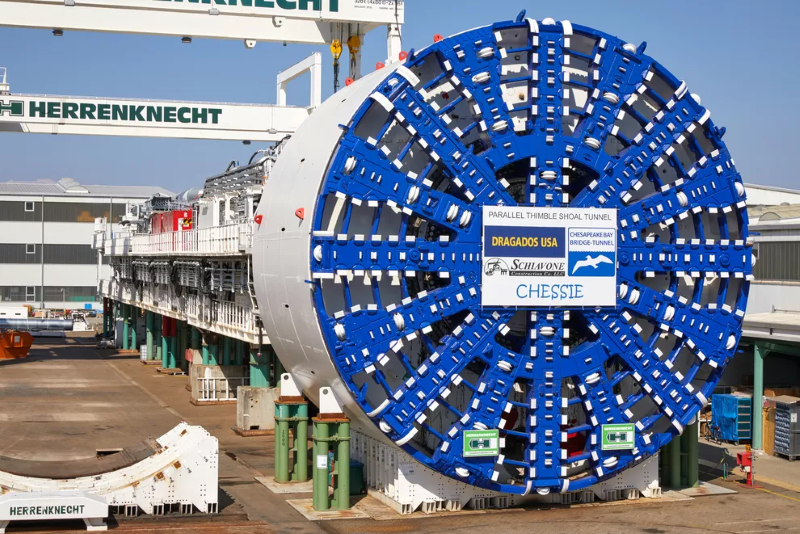New generation of tunneling is safe, proven
 Photo courtesy of Herrenknecht.
Photo courtesy of Herrenknecht.
Enbridge is ready to build Great Lakes Tunnel Project
Sept. 24, 2025
Editor’s note: This is the second part of a two-part series.
Tunnel projects are popping up all over the United States and around the world.
There are at least 30 major tunnel projects underway in the U.S., according to Tunnel Business Magazine.
They are being built to travel beneath bustling cities, through mountains and under bodies of water.
These construction projects will move people, help with drinking and storm water—and, in the case of Enbridge’s Great Lakes Tunnel Project, keep energy flowing to Michiganders. Enbridge’s Line 5 pipeline delivers light oil and natural gas liquids—building blocks for propane that heats homes and businesses, jet fuel for planes at Detroit Metro Airport, and more than 6,000 consumer products like eyeglasses, medicines, phones, and kayaks.
“The idea behind the Great Lakes Tunnel Project is to protect the waters of the Great Lakes by building a tunnel under the lakebed at the Straits of Mackinac to house a new segment of Line 5, making an already safe pipeline even safer,” said Erica Fink, Enbridge’s manager of operations for the Great Lakes Region.
The 21-foot-diameter tunnel could also house other utilities, such as fiber optic cables to provide internet service connecting the peninsulas and improving emergency services. The four-mile tunnel would be built and paid for by Enbridge.
“We’ve been sharing details of the project at our information center in St. Ignace, where visitors can see what the tunnel will look like,” continued Fink.
“Tunnels are improving the lives of many Americans. The good news is that they are safe and based upon proven technology.”
Virginia project showcases what’s to come in Michigan
 The Chessie tunnel boring machine. Photo courtesy of Herrenknecht.
The Chessie tunnel boring machine. Photo courtesy of Herrenknecht.
Currently, there are two tunnel projects in Virginia, both of which are extensions. One project adds a new underwater tunnel between Hampton and Norfolk, VA. The other project adds a new tunnel to move cars under the expansive Chesapeake Bay.
According to Paul Meneghini, Enbridge’s Manager of Community Engagement in Michigan, these projects are very similar to the one Enbridge plans to build once it attains a federal permit.
“We took a trip to Virginia and saw the tunneling operation firsthand and it was impressive,” said Meneghini.
“We are using the same company who built Chessie, the big tunnel boring machine (TBM) for the Virginia dig, to build us a TBM designed specifically for the Straits. They’re one of the best and most experienced companies in the world when it comes to this generation of tunneling.”
Herrenknecht, based in Germany and founded in 1975, has built dozens of TBMs for all sorts of successful projects from Europe to North America, from Seattle to Miami.
What makes this generation of tunneling possible?
TBMs, based on proven, reliable technology, bore into rock while simultaneously building the walls of a tunnel—a concept that would have once seemed like science fiction.
The modern-day TBM was created in 1952 by James Robbins for the Oahe Dam Project in South Dakota, introducing the rotating cutter head and circular shield that formed the basis for all subsequent TBMs.
Herrenknecht, the company that Enbridge is using for the Great Lakes Tunnel Project, is considered the worldwide market leader for heavy TBMs.
TBMs have already created tunnels under cities like Las Vegas, and there are plans to have an underground tunnel run from the Nashville airport to the Tennessee capital’s downtown core to ease congestion. Around the world there are ambitious projects: Norway plans to build the world’s longest and deepest subsea tunnel housing a road to get people moving.
TBMs resemble a slow-moving underground train with a rotating cutting wheel at the front end that grinds away at rock—which, along with other debris, is conveyed back to the surface. In back of the rotating head, segments of a reinforced concrete liner are lifted into place. To watch a detailed video on how a TBM works, click on this link to watch an animation.
 A full-scale model of the tunnel boring machine on display at the Great Lakes Tunnel Information Center.
A full-scale model of the tunnel boring machine on display at the Great Lakes Tunnel Information Center.
Ready to build
Enbridge is awaiting a federal permit so it can order the massive TBM for the Straits dig. The company says it has painstakingly conducted mineral and cultural surveys that will guide the project.
“We know how important this project is for the people of Michigan and the region. Michigan is home for about 100 Enbridge workers. We want to protect our home and safely deliver energy that people rely on every day. That’s what the Tunnel project will deliver,” said Fink.
“Once the Tunnel is built and Line 5 installed inside, my team has the great responsibility of overseeing the pipelines operations, just like we do every day 24/7. We can’t wait!”









